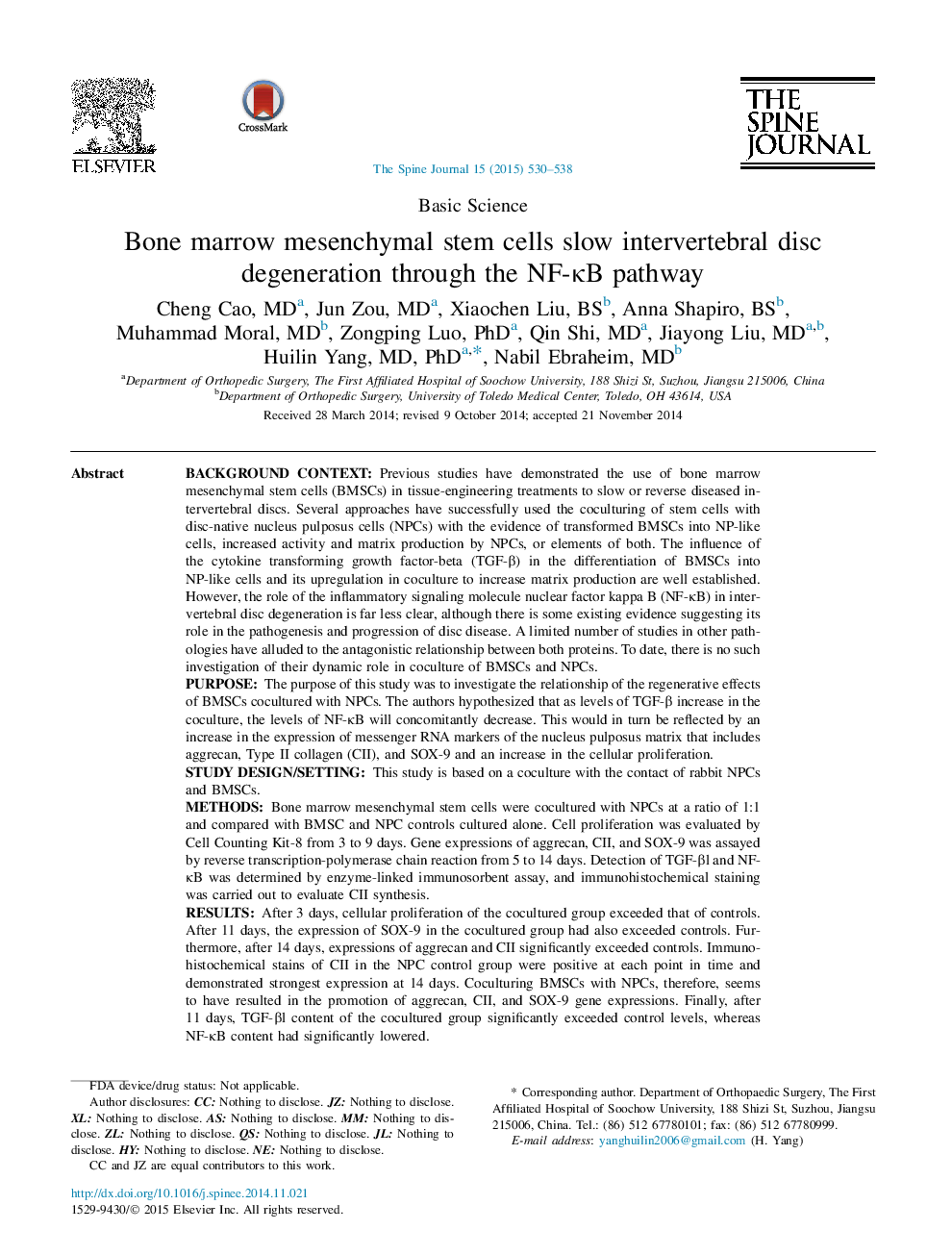| کد مقاله | کد نشریه | سال انتشار | مقاله انگلیسی | نسخه تمام متن |
|---|---|---|---|---|
| 4096723 | 1268569 | 2015 | 9 صفحه PDF | دانلود رایگان |

Background contextPrevious studies have demonstrated the use of bone marrow mesenchymal stem cells (BMSCs) in tissue-engineering treatments to slow or reverse diseased intervertebral discs. Several approaches have successfully used the coculturing of stem cells with disc-native nucleus pulposus cells (NPCs) with the evidence of transformed BMSCs into NP-like cells, increased activity and matrix production by NPCs, or elements of both. The influence of the cytokine transforming growth factor-beta (TGF-β) in the differentiation of BMSCs into NP-like cells and its upregulation in coculture to increase matrix production are well established. However, the role of the inflammatory signaling molecule nuclear factor kappa B (NF-κB) in intervertebral disc degeneration is far less clear, although there is some existing evidence suggesting its role in the pathogenesis and progression of disc disease. A limited number of studies in other pathologies have alluded to the antagonistic relationship between both proteins. To date, there is no such investigation of their dynamic role in coculture of BMSCs and NPCs.PurposeThe purpose of this study was to investigate the relationship of the regenerative effects of BMSCs cocultured with NPCs. The authors hypothesized that as levels of TGF-β increase in the coculture, the levels of NF-κB will concomitantly decrease. This would in turn be reflected by an increase in the expression of messenger RNA markers of the nucleus pulposus matrix that includes aggrecan, Type II collagen (CII), and SOX-9 and an increase in the cellular proliferation.Study design/settingThis study is based on a coculture with the contact of rabbit NPCs and BMSCs.MethodsBone marrow mesenchymal stem cells were cocultured with NPCs at a ratio of 1:1 and compared with BMSC and NPC controls cultured alone. Cell proliferation was evaluated by Cell Counting Kit-8 from 3 to 9 days. Gene expressions of aggrecan, CII, and SOX-9 was assayed by reverse transcription-polymerase chain reaction from 5 to 14 days. Detection of TGF-βl and NF-κB was determined by enzyme-linked immunosorbent assay, and immunohistochemical staining was carried out to evaluate CII synthesis.ResultsAfter 3 days, cellular proliferation of the cocultured group exceeded that of controls. After 11 days, the expression of SOX-9 in the cocultured group had also exceeded controls. Furthermore, after 14 days, expressions of aggrecan and CII significantly exceeded controls. Immunohistochemical stains of CII in the NPC control group were positive at each point in time and demonstrated strongest expression at 14 days. Coculturing BMSCs with NPCs, therefore, seems to have resulted in the promotion of aggrecan, CII, and SOX-9 gene expressions. Finally, after 11 days, TGF-βl content of the cocultured group significantly exceeded control levels, whereas NF-κB content had significantly lowered.ConclusionsCoculture of BMSCs may be able to delay NPC matrix degeneration potentially through the concomitant upregulation of TGF-β and the downregulation of NF-κB pathway.
Journal: The Spine Journal - Volume 15, Issue 3, 1 March 2015, Pages 530–538